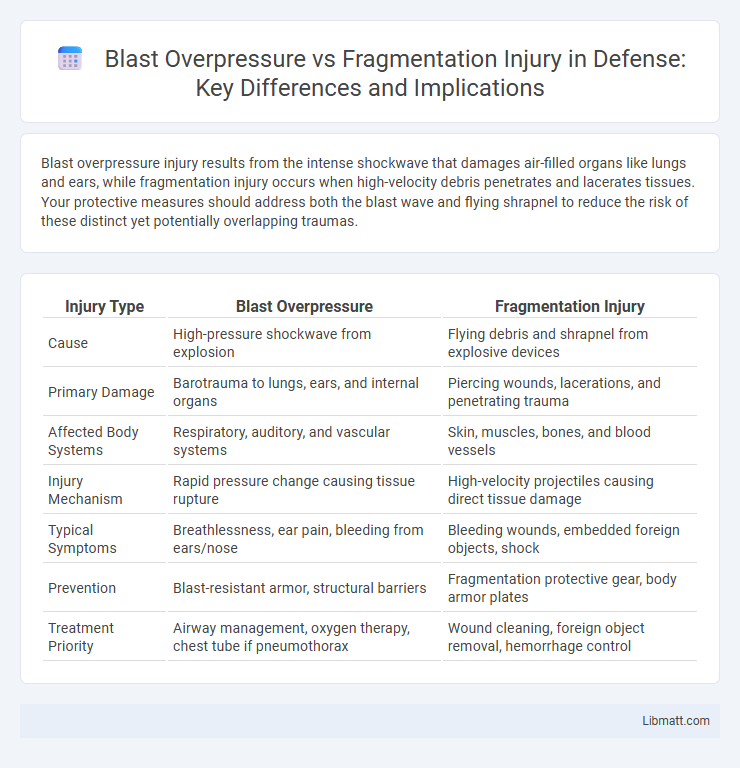Blast overpressure injury results from the intense shockwave that damages air-filled organs like lungs and ears, while fragmentation injury occurs when high-velocity debris penetrates and lacerates tissues. Your protective measures should address both the blast wave and flying shrapnel to reduce the risk of these distinct yet potentially overlapping traumas.
Table of Comparison
| Injury Type | Blast Overpressure | Fragmentation Injury |
|---|---|---|
| Cause | High-pressure shockwave from explosion | Flying debris and shrapnel from explosive devices |
| Primary Damage | Barotrauma to lungs, ears, and internal organs | Piercing wounds, lacerations, and penetrating trauma |
| Affected Body Systems | Respiratory, auditory, and vascular systems | Skin, muscles, bones, and blood vessels |
| Injury Mechanism | Rapid pressure change causing tissue rupture | High-velocity projectiles causing direct tissue damage |
| Typical Symptoms | Breathlessness, ear pain, bleeding from ears/nose | Bleeding wounds, embedded foreign objects, shock |
| Prevention | Blast-resistant armor, structural barriers | Fragmentation protective gear, body armor plates |
| Treatment Priority | Airway management, oxygen therapy, chest tube if pneumothorax | Wound cleaning, foreign object removal, hemorrhage control |
Understanding Blast Overpressure Injuries
Blast overpressure injuries result from the sudden and intense rise in atmospheric pressure caused by an explosion, which primarily affects air-filled organs such as lungs and ears, potentially causing severe hemorrhaging and rupture. Fragmentation injuries occur when high-velocity shrapnel penetrates the body, creating wounds that can lead to extensive tissue damage, infection, and bleeding. Understanding the distinct mechanisms and symptoms of blast overpressure versus fragmentation injury is crucial for effective diagnosis and treatment of blast trauma in your emergency response protocols.
What is Fragmentation Injury?
Fragmentation injury occurs when high-velocity shrapnel or debris from an explosive device penetrates the body, causing tissue damage and secondary trauma beyond the initial blast wave. Unlike blast overpressure, which primarily affects organs through rapid pressure changes, fragmentation injuries result from physical penetration and laceration by flying projectiles. These injuries often lead to complex wounds with embedded foreign materials, increasing the risk of infection and complicating medical treatment.
Key Differences: Overpressure vs. Fragmentation
Blast overpressure injury results from the rapid increase in atmospheric pressure caused by an explosion, primarily affecting air-filled organs such as the lungs, ears, and gastrointestinal tract. Fragmentation injury is caused by high-velocity projectiles or shrapnel propelled by the blast, leading to penetrating trauma and tissue laceration. Key differences include the mechanism of injury, with overpressure affecting internal organs through pressure waves, while fragmentation causes direct physical damage through impact wounds.
Mechanisms of Injury: Pressure Waves vs. Projectiles
Blast overpressure injuries result from rapid changes in atmospheric pressure that cause damage to air-filled organs such as lungs and eardrums by generating intense pressure waves. Fragmentation injuries occur when high-velocity projectiles or shrapnel penetrate the body, causing localized tissue damage and hemorrhage. Your understanding of these mechanisms highlights that pressure waves primarily induce internal barotrauma, while projectiles inflict direct traumatic wounds through physical penetration.
Clinical Presentations of Blast Overpressure Injuries
Blast overpressure injuries primarily manifest as traumatic brain injury, pulmonary barotrauma, and tympanic membrane rupture due to rapid pressure changes. Clinical presentations include altered mental status, hypoxia from lung contusions, and hearing loss or vertigo. These symptoms often coexist with fragmentation injuries, which cause penetrating wounds and hemorrhage, complicating diagnosis and management.
Common Signs of Fragmentation Injury
Common signs of fragmentation injury include numerous small puncture wounds or lacerations caused by high-velocity shrapnel impacting soft tissues. Victims often exhibit localized bleeding, swelling, and embedded foreign materials such as metal fragments. Secondary complications may involve infection risk and tissue necrosis around the injury sites due to the penetrating nature of the fragments.
Diagnosis: Distinguishing the Injury Types
Diagnosis of blast injuries requires differentiating overpressure damage from fragmentation wounds by analyzing injury patterns and clinical findings. Blast overpressure typically causes barotrauma affecting air-filled organs such as the lungs, ears, and gastrointestinal tract, with symptoms like pulmonary edema or tympanic membrane rupture. Fragmentation injuries present as penetrating wounds with foreign bodies embedded in tissues, often confirmed through imaging studies like X-rays or CT scans detecting metal fragments or shrapnel.
Treatment Protocols for Each Injury
Treatment protocols for blast overpressure injuries prioritize rapid assessment of respiratory and auditory damage, using oxygen therapy, bronchodilators, and hyperbaric oxygen if necessary. Fragmentation injuries require thorough wound cleaning, surgical debridement, and tetanus prophylaxis, with antibiotics to prevent infection and possible reconstructive surgery for soft tissue damage. Both injury types demand continuous monitoring for secondary complications such as infection, pulmonary edema, and traumatic brain injury.
Prevention and Protective Measures
Blast overpressure and fragmentation injuries require distinct prevention and protective measures due to their differing mechanisms of harm. Blast overpressure protection emphasizes using reinforced barriers, blast-resistant structures, and proper distance to reduce the impact of shock waves on Your body. To guard against fragmentation injuries, wearing body armor with high-quality ballistic materials and incorporating protective helmets and shields is essential for minimizing penetration and shrapnel damage.
Long-term Outcomes and Rehabilitation
Blast overpressure injuries often result in traumatic brain damage and lung complications, leading to complex long-term cognitive and respiratory deficits requiring specialized neurorehabilitation and pulmonary therapy. Fragmentation injuries typically cause localized soft tissue damage and bone fractures, necessitating extended physical rehabilitation and reconstructive surgeries to restore function and mobility. Your recovery process depends on a tailored multidisciplinary approach addressing both neurological and musculoskeletal impairments to optimize long-term outcomes.
blast overpressure vs fragmentation injury Infographic

 libmatt.com
libmatt.com